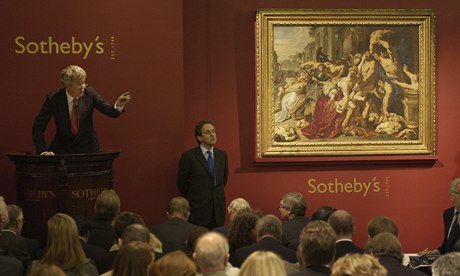What sells art?

Mass infanticide – suprisingly desirable … The Massacre of the Innocents by Peter Paul Reubens fetched £49.5m at auction. Photograph: Fiona Hanson/PA
Last year a version of Edvard Munch’s The Scream fetched $120m (£74m) at auction; in 24 hours last week, a Warhol made $105m (£65m) and a Bacon portrait of Freud reached $143m (£89m). To the outside world, the pricing of art is a mystery. Why does one work sell for £10,000, another for £1m, and yet another for £100m?
Obviously, who paints the picture is important. Artists are brands that can go in and out of fashion. As recently as 10 years ago, the highest auction price for Francis Bacon stood at $8.5m. The record $143m that was paid last week is a measure of a shift in taste: whereas 40 years ago the highest prices were achieved by old masters, now huge glamour and demand is focused on modern and contemporary art. It also reflects the greater availability of top-quality modern works than of top-quality old masters, which are increasingly rare.
There are certain eternals who will always be valuable. It is hard to imagine art history ever downgrading the importance of Rembrandt or Rubens, Leonardo or Raphael, Picasso or Matisse. But in recent years artists such as the surrealists and the German expressionists have grown more expensive as their importance in the history of art has been reassessed. Similarly, if an artist has just featured in a major exhibition at the Tate, for example, then that kind of high-profile exposure can also create a spike in their prices.
Another factor that enhances an artist’s value is what I call “positive romantic baggage”. There is a back-story to artists’ lives that affects our appreciation of them and the works they produce. Quite apart from the importance to art history of Van Gogh and his significance as the originator of expressionism, there is a tragic romance to his life that enhances his value to the collector, emotionally and financially.
Other commercial positives in an artist’s life story include unhappy love affairs, close attachment to specific easy-on-the-eye “muses”, madness (but not illness, which buyers subliminally associate with a fall-off in quality), rebellious behaviour and even spells in jail. Dying young is sometimes not a bad career move, either. Munch, Bacon and Warhol all had colourful private lives that play into their myth, and therefore enhance the price that their best work realises.
Similarly, some periods of an artist’s career are more desirable than others. Late Van Gogh is more expensive than his early work. A Renoir from the 1870s will be worth more than a late one. Any Picasso is desirable, but one from the early 1930s particularly so.
What the market also prizes is high recognisability. You want the Monet you have just splashed out on to be immediately obvious as a Monet to visitors to your living room. Thus a painting showing waterlilies or Rouen Cathedral will be more expensive than a less typical portrait or still life by the artist. Munch’s The Scream has this in abundance. Most people will recognise the Bacon portrait or Warhol’s Silver Car Crash when they come into the owners’ living rooms.
In traditional painting, some subjects are definitely more desirable than others: portraits of pretty women will always sell better than those of gloomy old men; sunny landscapes are more expensive than dark ones, and calm seas preferable to rough ones. Animals and birds are generally more expensive if you can shoot them, but they should preferably be depicted alive because in general death in a painting is bad news. Nudes, provided the models are beautiful, sell well (but they can be difficult for some Islamic buyers, an important consideration in today’s market). Biblical subjects are out of fashion. But a major work by a great master has the capacity to transcend all rules. In 2002 Sotheby’s sold a Rubens, The Massacre of the Innocents. As a scene of mass infanticide it was not immediately promising material, but it made £49m.
Condition is a factor. Paintings suffer and age over time, some more than others. Like human beings, some are subjected to cosmetic surgery. Where this has been too extensive, the price of the painting will be affected. The history of the painting itself can also make a difference to its value: whose collection it has been in, where it has been exhibited, which dealers have handled it. A Cézanne from the great Paul Mellon collection is worth more than the same painting with an unspecified provenance. Conversely, the name of Field Marshal Göring in the list of previous owners of your picture – even if he came by it legally – isn’t necessarily a bonus.
The final question is the most important, and the most elusive. Has the painting got “wallpower”, the visceral impact that makes people want to own it? This is a matter of factors such as composition, colour (blue and red tend to be good news) and emotional power. Surpassing artistic quality (difficult to define, but you know it when you see it) is always reflected positively in the price a work of art realises, sometimes to an astonishing extent. A good example of an artist’s work may fetch £100,000, but a superlative one could spiral off the dial and make £1,000,000. In this respect, at least, the art market has got its values right.
By Philip Hook
Source: http://www.theguardian.com
• Philip Hook is a Director and Senior Paintings Specialist at Sotheby’s. Breakfast at Sotheby’s: an A-Z of the Art World, is published by Particular Books